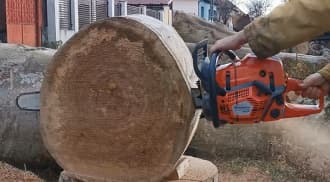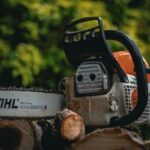As an Amazon Associate, this site earns commissions from qualifying purchases. For more information click here.
Chainsaws are reliable power tools, but with that power comes potential health risks. For this reason chainsaws are equipped with a host of safety features. The chain brake is one of those that has been around for a while. But is it possible to use a chainsaw minus the chain brake? The answer to this question and more is right here.
The chain brake stops the cutting chain from moving during a kickback. It is designed to prevent injuries so you must never use a chainsaw without this feature. All chainsaws are required to have this safety mechanism built in.
What is the Purpose of a Chain Brake?
A chain brake literally puts the brake on the chainsaw blade (the chain). It does so by putting a metal brake band on the driven clutch drum.
Chainsaw chain brakes have two goals: to protect you in case of a kickback and secondly, secure the chain when cold starting the saw.
Kickback protection. Kickback happens when the nose of the bar hits an object and the chain gets pinched. This causes the bar to move up and toward the chainsaw operator. The impact of the bar and the rotating chain can lead to serious injuries.
This is why chainsaws have chain brakes and why you have to make sure it is working. If yours is damaged, get a replacement. If you own a Husqvarna chainsaw, you can get a chain brake assembly for it.
The chain brake minimizes the risk of injury should a kickback happen. To engage the brake, the top hand guard pushes it forward. To disengage, it is pulled back. Even if the chainsaw is running at full power, engaging the brake will stop it in less than a second.
Chain brakes may be triggered manually or automatically if there is a kickback. A manual chain brake requires you to rotate your left wrist and push the top hand guard. If the kickback causes your left hand to lose grip of the handle, the top hand guard will still fall in your hand. This will automatically trigger the chain brake.
Some chainsaw brakes are integrated with the handle. If the bar suddenly moves upward, the brake is automatically set off, halting the chain.
Securing the chain. A chain brake is also useful when trying to start a cold chainsaw. A cold start usually means the throttle has to be opened partially. Without a chain brake the blade will be difficult to control and pose real danger.
The bottom line is that a chain brake is essential. Whether you are cutting trees, logs or concrete, safety always comes first.
How Chainsaw Brake Systems Work
There are many types of chain brake systems. Chain brakes on Stihl chainsaws are usually integrated in the casing, while Husqvarna brakes are on the sprocket cover. While there are differences, how they work is generally the same.
If the chainsaw has an automated chain brake, it engages the brake when there is a kickback. If is a manual design, you have to push the hand guard.
Once the brake is engaged, a tension spring gets triggered and a steel band keeps the clutch drum from turning. When you disengage the brake, the band loosens the clutch.
Some chainsaws have additional kickback protection. Stihl chainsaws have a Quickstop brake that automatically stops the chain from moving. This can be triggered by the operator or activated during a kickback.
There are also chain brake systems that halt the chain when your hand lets go of the rear handle. Throttle lockout lever activates this safety mechanism if the rear handle is released. Stoppage of the chain takes place in a second or less.
Electric chainsaws have similar features but they are turned on electronically. Whether it is electric or gas, protection is essential. With a chain brake, you are protected from the kickback zone.
Why Your Chainsaw Must Have a Chain Brake
Now that you know how a chain brake system works, it is easy to understand the benefits. The following are some of the biggest advantages.
Enhances safety. The kickback is one of the biggest risks a chainsaw operator faces. The chain brake serves as a solid protection against it. This is the reason why all chainsaws – gas, corded, cordless – have this feature.
Protection from other dangers. Chain brake systems do more than protect you from kickback. The system shields your left hand from sharp branches while you are cutting and clearing them off.
When the chain brake is on, it keeps your hand safe from accidents while walking. If you are cutting a tree, you might trip over something and fall. This can lead to a dangerous or fatal accident. By activating the chain brake when you walk, this possibility is removed.
Because a lot of chain brakes automatically run in a kickback situation, you can focus on cutting. Of course you should not 100% rely on the brake. Learning all the safety precautions is a must, but the brake adds another level of security.
If you have been using a chainsaw for a long time, it might be tempting to start the tool with the feature off. You might even feel the urge to disengage this because you are already accustomed to a Husqvarna 445 for instance.
Even if you are already familiar with a chainsaw, it is always better to play it safe. You might be cutting wood for a .long time and not realize you are tired. A single slip up could result in a painful injury. If you can take steps to avoid it, you should do so.

Can You Use a Chainsaw without a Chain Brake?
You must not use a chainsaw without a chain brake because it can result in serious injuries. Many countries also require chainsaws to have a chain brake. You cannot sell these tools without this safety component.
Can you start a chainsaw without a brake? Yes, just start it the way you normally would. The difference is that you do not have any protection. It was only during the early 1970s when chain brakes became regular fixtures on these tools.
If you have a very old chainsaw, it probably does not have a chain brake. You cannot install it on older models so it is time to buy a new one. And there is no situation where you should be using this tool without the brake.
To keep it simple: if your chainsaw does not have a chain brake, or the brake does not work, do not use it. You are putting yourself at risk. Second, many government agencies prohibit using a chainsaw without a chain brake. Not only can you get injured, but you can end up in legal trouble too.
You may have seen some people use chainsaws without a chain brake. While technically possible, it is not a good idea. Why risk potential injury when it can be avoided? This does not mean chain brakes are 100% efficient – no safety feature is – but you reduce the risk significantly.
Should Chainsaws Start with the Brake On?
The brake must always be engaged when you start a chainsaw so the chain does not move. You might be able to start a chainsaw with the brake off, but for safety reasons you should not.
If you read your owner’s manual, it will state that the brake must always be engaged during startup. If you take a chainsaw safety test and disengage the brake, you will fail the exam.
You should only disengage the brake when you are ready to cut and in full control of the tool. If you are finished cutting, engage the brake. If you are going to take more than a couple of steps, put the brake on. Do not walk around with the chain brake off because it is dangerous.
If the chain brake is not working, the chainsaw needs cleaning. This is something you should do regularly not just for the brake but to keep the engine humming. If the chain is broken, check the manufacturer site for replacement parts.

I love the outdoors and all the tools for maintaining gardens, yards and lawns. The only thing I am more passionate about is sharing what I know about garden and outdoor equipment.


